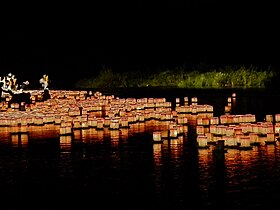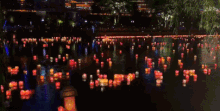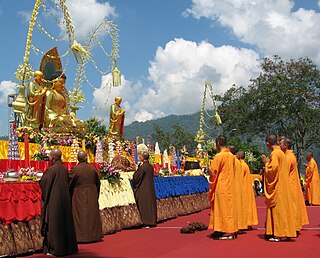
Vesak, also known as Buddha Jayanti, Buddha Purnima, Buddha Day, is a holiday traditionally observed by Buddhists in South Asia and Southeast Asia, as well as Tibet and Mongolia. It is the most important Buddhist festival. The festival commemorates the birth, enlightenment (Nibbāna), and passing (Parinirvāna) of Gautama Buddha in Theravada, Tibetan Buddhism and Navayana.

The Mid-Autumn Festival, also known as the Moon Festival or Mooncake Festival, is a harvest festival celebrated in Chinese culture. It is held on the 15th day of the 8th month of the Chinese lunisolar calendar with a full moon at night, corresponding to mid-September to early October of the Gregorian calendar. On this day, the Chinese believe that the moon is at its brightest and fullest size, coinciding with harvest time in the middle of autumn.

The Lantern Festival, also called Shangyuan Festival and Cap Go Meh, is a Chinese traditional festival celebrated on the fifteenth day of the first month in the lunisolar Chinese calendar, during the full moon. Usually falling in February or early March on the Gregorian calendar, it marks the final day of the traditional Chinese New Year celebrations. As early as the Western Han dynasty, it had become a festival with great significance.

The Ghost Festival or Hungry Ghost Festival, also known as the Zhongyuan Festival in Taoism and the Yulanpen Festival in Buddhism, is a traditional festival held in certain East and Southeast Asian countries. According to the Chinese calendar, the Ghost Festival is on the 15th night of the seventh month.

Loy Krathong is a Thai festival celebrated annually throughout Thailand and in nearby countries with significant South Western Tai cultures. The name could be translated as "to float ritual vessel or lamp," and comes from the tradition of making krathong or buoyant, decorated baskets, which are then floated on a river. Many Thais use the krathong to thank the Goddess of Water and River, Goddess Khongkha or to worship the Holy Buddha's hair pagoda in heaven in Buddhist beliefs. This festival traces its origin back to India.
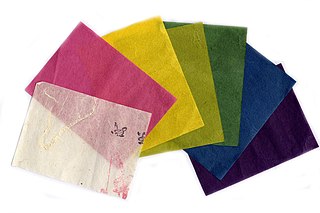
Washi (和紙) is traditional Japanese paper processed by hand using fibers from the inner bark of the gampi tree, the mitsumata shrub, or the paper mulberry (kōzo) bush.

The Hyakumangoku Matsuri (百万石まつり) is the main annual festival taking place in Kanazawa, Japan. The festival commemorates the entry of Lord Maeda Toshiie into Kanazawa Castle in 1583. The highlight of the festival is the Hyakumangoku Parade, which has begun on the first Saturday in June since 2007.

A paper lantern is a lantern made of thin, brightly colored paper. Paper lanterns come in various shapes and sizes, as well as various methods of construction. In their simplest form, they are simply a paper bag with a candle placed inside, although more complicated lanterns consist of a collapsible bamboo or metal frame of hoops covered with tough paper.

The Hiroshima Panels are a series of fifteen painted folding panels by the collaborative husband and wife artists Toshi Maruki and Iri Maruki completed over a span of thirty-two years (1950–1982). The Panels depict the consequences of the atomic bombings of Hiroshima and Nagasaki, as well as other nuclear disasters of the 20th century. Each panel stands 1.8 metres x 7.2 metres.

Buddha's Birthday or Buddha Day is a primarily Buddhist festival that is celebrated in most of South, Southeast and East Asia, commemorating the birth of the prince Siddhartha Gautama, who became the Gautama Buddha and founded Buddhism. According to Buddhist tradition and archaeologists, Gautama Buddha, c. 563-483 BCE, was born at Lumbini in Nepal. Buddha's mother was Queen Maya Devi, who delivered the Buddha while undertaking a journey to her native home, and his father was King Śuddhodana. The Mayadevi Temple, its gardens, and an Ashoka Pillar dating from 249 BCE mark the Buddha's birth place at Lumbini.

Hội An, formerly known in the Western world as Faifoo or Faifo, is a city with a population of approximately 120,000 in Vietnam's Quảng Nam Province, registered as a UNESCO World Heritage Site since 1999. Along with the Cù Lao Cham archipelago, it is part of the Cù Lao Cham-Hội An Biosphere Reserve, designated in 2009.

The Water Festival is the New Year's celebrations that take place in Southeast Asian nations such as Thailand, Laos, Myanmar, and Cambodia as well as among the Dai people of China, and the southern parts of Vietnam. It is part of the broader South and Southeast Asian solar New Year. It is called the 'Water Festival' by Westerners because they notice people splashing or pouring water at one another as part of the cleansing ritual to welcome the Songkran New Year. Traditionally, people gently sprinkled water on one another as a sign of respect, but as the new year falls during the hottest month in South East Asia, many people end up dousing strangers and passers-by in vehicles in boisterous celebration. The act of pouring water is also a show of blessings and good wishes. It is believed that at this Water Festival, everything old must be thrown away, or it will bring the owner bad luck.
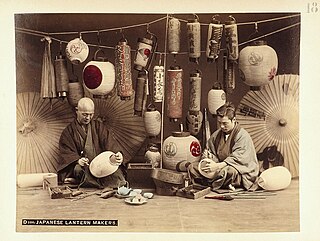
The traditional lighting equipment of Japan includes the andon (行灯), the bonbori (雪洞), the chōchin (提灯), and the tōrō (灯篭).

A sky lantern, also known as Kǒngmíng lantern, or Chinese lantern, is a small balloon made of paper, with an opening at the bottom where a small fire is suspended.
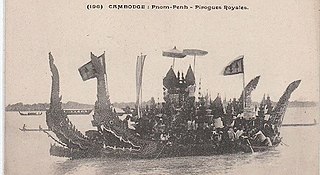
Bon Om Touk, also known as the Cambodian Water Festival, is celebrated in late October or early November, often corresponding with the lunar Mid-Autumn Festival. It marks the end of the monsoon season. The festivities are accompanied by dragon boat races, similar to those seen in the Lao Boun Suang Huea festival.
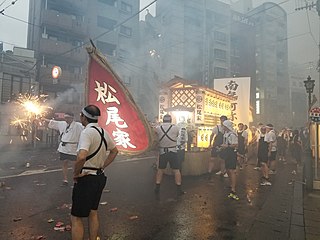
The Spirit Boat Procession is an event celebrated in various places in Nagasaki prefecture, Japan. It is part of the Bon Festival. During the event, the souls of the deceased are mourned.

Bua loi or bua loy is a Thai dessert. It consists of rice flour rolled into small balls, and cooked in coconut milk and sugar. Some Bua loi also adds sweet egg into the recipe. It was inspired by Tangyuan, a Chinese dessert that is traditionally eaten around the Lantern festival. Bua Loi also traditionally eats at the Dongzhi Festival in Thailand, which is festival for the Chinese-Thai bloodline. There are a variety of versions of Bua loi such as using food coloring instead of natural color, using soy milk instead of Coconut cream, sliced Pumpkin to add inside rice balls, et cetera. There's other type of Bua loi in other country from China, Japan, Indonesia, Myanmar, Philippines, Southern Vietnam and Malaysia. 1 cup of Bua Loy has total calories of 295.5 kilocalories, protein of 10.4 grams, carbohydrate of 6.3 grams, and fat of 25 grams.

Fruit carving is the art of carving fruit, a very common technique in Europe and Asian countries, and particularly popular in Thailand, China and Japan. There are many fruits that can be used in this process; the most popular one that artists use are watermelons, apples, strawberries, pineapples, and cantaloupes.
